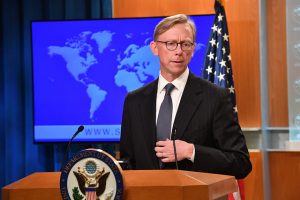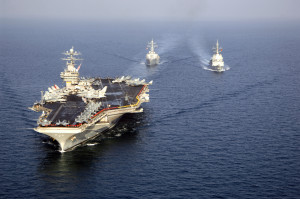by Sina Toossi
With nuclear negotiations between Iran and six world powers set to resume on January 18 in Geneva, no breakthrough in the talks is in sight. This deadlock begs the questions: what is the logic behind Iranian foreign policy, and why do Iran’s policymakers appear so intractable in the face of an unprecedented sanctions regime?
Any honest effort to understand Iran’s approach to its nuclear program should take into account Iran’s strategic vision—that is, the lens through which key decision-makers and stakeholders within the Islamic Republic view the world and the country’s struggle for power in the international system. In this regard, Iran, like most states, wants to maximize its security in an anarchic global order.
To ensure its survival, Iran has pursued a more-or-less consistent grand strategy since the Islamic Republic’s inception in 1979. Like the late Shah Mohammad Reza Pahlavi, the Islamic Republic has sought to preserve and enhance Iran’s national security and stability. Indeed, Iran’s structural characteristics—its location, size, demographics, resources—ensure that it will always be a critical country in the Middle East regardless of the type of government in Tehran. In his recent book Nixon, Kissinger, and the Shah, Roham Alvandi highlights the efforts made even by the Shah to establish Iranian regional primacy in the Persian Gulf and shift the country’s relationship with the United States during the Nixon era from a patron-client status to a more mutually beneficial partnership.
However, though Iran is a structurally powerful country capable of gaining a preeminent position in the region, the particular strategy it pursues to maximize its security depends on the decision-making structure in Tehran. The Islamic Republic distinguished itself in this regard from the Shah’s regime by prioritizing Iran’s strategic independence. The Islamic Republic’s founder, the late Ayatollah Ruhollah Khomeini, promoted the idea of Iran becoming a strategically independent actor as a foundation of his Islamist ideology.
Khomeini’s emphasis on strategic independence, of Iran being “neither East nor West” in its geopolitical alignment, was the outcome of a pre-1979 revolutionary discourse that portrayed foreign powers as wishing to subjugate Iran, retard its development, and gain strategic control of its resources and location. Regardless of its accuracy, this narrative was pervasive in pre-revolution Iran. Its proponents, who came from diverse political and religious backgrounds, could point to incidents such as the British and Russian overthrow of Iran’s first civic constitution and elected parliament in 1911 and the infamous coup d’état that the United States and UK orchestrated to unseat the democratically elected Prime Minister Mohammad Mossadegh in 1953.
Creating Strategic Depth
The Islamic Republic’s prioritizing of strategic independence—a core aspect of its legitimacy—has shaped the way it has conducted international affairs. It has, for instance, aimed to maximize its security through developing its own sphere of influence. At its establishment, the Islamic Republic had no strategic depth, with its revisionist status putting it at odds with practically all of its neighbors and ensuring an all-but-nonexistent buffer zone with all potential enemies.
The Islamic Republic’s aim of establishing its own strategic depth stands in contrast to the Shah’s fundamental strategy of gaining U.S. military support and security guarantees in exchange for policing the Persian Gulf on the U.S. behalf. Iran under the Islamic Republic has demonstratively repudiated the Shah’s strategy by carving out a sphere of influence from Lebanon to Yemen to Afghanistan, inextricably altering the balance of power in the region. Iran has effectively shifted from being a marginalized state in regional affairs, which it had been for past several centuries, to becoming an assertive, independent power in its region. The Islamic Republic has pursued this strategy despite the costs in economic development measured in lost foreign investment and trade, imposed sanctions, and so on.
Much of the strategic depth and regional influence Iran has gained over the past few decades has been aimed at deterring security threats from the United States. A perpetual concern for Iran’s leaders since the revolution has been that the United States seeks to topple the Islamic Republic and reestablish the kind of pro-American order than existed under the Shah.
Fear of U.S. Actions
This perennial fear of American intervention has steered Iran’s overall security agenda. Although Iran’s leaders have pushed back against what they frame as U.S. efforts to control the region at the expense of Iran, they have also consistently stressed that they view security in the region as a non-zero sum game. Furthermore, Iranian officials have signaled repeatedly that they prefer a scenario in which the United States accommodates Iran in its regional security architecture in a way that preserves Tehran’s own independent security prerogatives.
Iran has shown that it will respond to such inclusion in ways that are positive for U.S. interests in the region. For instance, Iran supported U.S. efforts in Bosnia in the 1990s by sending arms to the Bosnians at the request of the Clinton administration. Iran also helped the United States oust both the Taliban in Afghanistan and Saddam Hussein in Iraq and prop up their replacements.
However, when Iran has felt most excluded and threatened by the United States, it has sought to raise the costs of its exclusion by making it more difficult for the United States to achieve its strategic interests in the region. For instance, Iran has supported attacks by its proxies against American interests and has intervened in the Israeli-Palestinian conflict to advance its own interests. Kayhan Barzegar summarizes Iranian strategic thinking:
From the perspective of Iranian governing elites…Iran is paying a great price for preserving regional security, without receiving appropriate gains in return. If the region’s security is significant to the United States and regional states, there needs to be an acknowledgement of the reality that Iran is an essential part of the region’s security system. Iran will not continue to ensure that the region is secure at the expense of Iran’s own insecurity. By pursuing this policy, Tehran also aims to warn other states in the region of the cost of helping the United States in any possible future military operations against Iran, making it clear that such actions would result in greater insecurity for the entire region.
Through its actions in the region, Iran has by and large signaled its preference to minimize the threat posed by the U.S. presence in its region through cooperation and engagement, but only if the United States does not seek to subordinate Iranian interests to its own. Iranian leaders believe that coming to some sort of strategic settlement with the United States is essential if Iran is to become the sort of regional power that best maximizes the country’s national security.
Iranian strategists view the crisis over Iran’s nuclear activities as a proxy for isolating Iran geopolitically, reining in its regional influence, and enabling the United States to expand its own hegemonic ambitions in the Middle East at the expense of an ascendant Iran. Hence, the key to resolving the nuclear impasse is to instill confidence in Iranian negotiators that any concessions Iran delivers on its nuclear program will not diminish Iran’s hard-fought sphere of influence or security interests in the region.
This is arguably a favorable strategic outcome for the United States as well, given Iran’s significant influence in Iraq, Syria, Afghanistan, and the Persian Gulf. If the United States shows a willingness to recognize Iranian security concerns in the Middle East and reach a mutual, face-saving compromise with Iran over its nuclear program, a nuanced study of Iran’s grand strategy suggests that Iran will respond positively and in ways that would benefit America’s strategic goal of reducing its footprint in the Middle East and “pivoting” to Asia.
Sina Toossi the assistant editor of the Institute for Policy Studies’ Right Web Project, which examines with a scholarly eye the individuals and organizations promoting aggressive U.S. foreign policies. He holds an MA in international affairs from American University’s School of International Service, with a regional concentration in the Middle East. His writings have appeared on Muftah and Foreign Policy in Focus.
This article is a summary of a section of Sina Toossi’s capstone research project for his master’s degree at American University’s School of International Service. His paper dealt with analyzing the criteria for U.S./Iran cooperation through the lens of John Mearsheimer’s offensive realism theory and by examining the structural and national level decision making factors influencing the grand strategies of both countries
Photo: Iran’s President Hassan Rouhani greets a rally in commemoration of the Islamic Republic’s 35 anniversary of its 1979 revolution in Tehran, Iran on Feb. 11, 2014. Credit: ISNA/Hamid Forootan






To my view this is a realistic interpretation of visions of Iranian policymakers. US has overtly and covertly tried and failed at repeated attempts in regime change, which has further pushed the two sides apart. By mulling over dismissal of Mosaddegh earlier and recent events in Egypt they even explain away, at least in their own mind, their present relationship with the west especially the US.
Both side can accommodate each other for a mutual benefit.